
A segmental-headed limestone pediment above the tall first floor window on the northern projecting bay of the original Custom House. This feature is a common decorative device used to add interest to a classical façade. The combination of segmental headed pediments and triangular pediments found at first floor level on the Custom House is most closely associated with the work of Michelangelo, as talented and important an architect as he was a sculptor. Michelangelo interpreted the rules of Roman classical architecture and used them in an innovative, while still classically rigorous way.
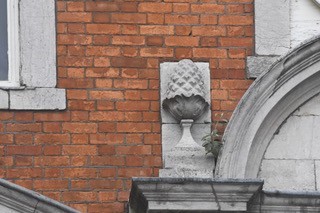
A pineapple-shaped carved limestone finial. There are two pineapple-shaped finials above the central doorway of the original Custom House building, which was built in 1724 and originally faced the King’s Dock (now Emmet Place). The pineapple was a popular architectural motif in the 18th and 19th centuries, and in many cases it is used as a symbol of hospitality. A thriving trade in pineapples between Europe and the Caribbean emerged in the late 17th century, and they became a prestigious symbol of international trade. There are tales of American sea captains who, upon returning from a voyage, would place a pineapple outside their home as a symbol of their safe return.
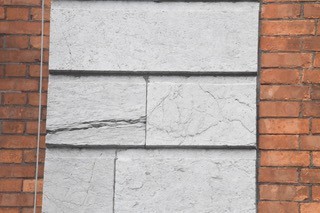
Shallow white limestone blocks are used to articulate the corners of the projecting bays on the eastern faced of the original 1724 Custom House building. The beautiful silvery-white local Cork limestone used to form the decorative details of this building were intended to provide a visual contrast to the original red brick, which is likely to have been imported, possibly from the Netherlands. The brick we can now see on the building dates from 1884, when the original red brick was replaced with new brick to match the extension of that date.
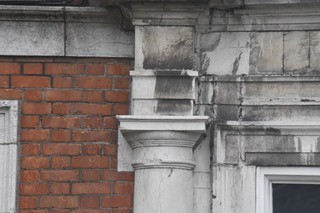
The central bay of the eastern façade of the original 1724 Custom House is flanked by two storeys of engaged limestone columns. At ground floor level, to either side of what would originally have been the main entrance to the building, is a pair of Tuscan columns. The term ‘Tuscan’ here refers to one of the five classical orders: Tuscan, Doric, Ionic Corinthian and Composite. The orders are most easily recognisable by the differences in the carved details of the capitals at the top of their columns. Here, the capital of this column indicates the simplest of the five orders: the Tuscan order, with a plain, square capital above a bulbous astragal.
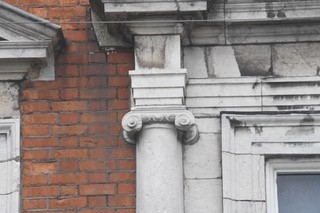
The central bay of the eastern façade of the original 1724 Custom House is flanked by two storeys of engaged columns. Here, at first floor level, on either side of the tall central window, there is a pair of Ionic columns. The Ionic order is recognisable by the curved volutes at the four corners of the capital, at the top of the column. The first floor of the Custom House was the most important of the building’s three original floors: behind these central bays lies the Long Room, where revenue payments due on goods arriving into the port of Cork were formally paid to clerks working at long tables to prepare bills of lading for ships sailing to and from Cork. The Crawford Gallery retains the original internal plan form of the Long Room.

This terracotta ventilation grille is set into the façade of the original Custom House, but it dates to the 1884 extension and alterations to the building. It is a decorative expression of the utilitarian function of providing air to the interior of the building. Victorian architects are renowned for the care they often took in the detailing of functional building elements.
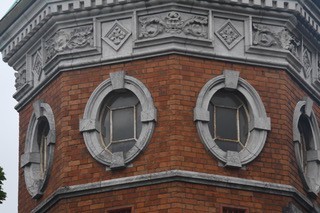
After a new Custom House was built at the entrance to the Port of Cork in 1811, the earlier Custom House was given to the Royal Cork Institution, later becoming a Government School of Design and then the Crawford School of Art. A magnificent extension was added, funded by and named after William Horatio Crawford (of Beamish & Crawford brewers) to house the Crawford School of Art in 1884. The extension was designed by Cork architects Henry & Arthur Hill, and it uses the same palette of materials as the Custom House: red brick and local white limestone. The architectural expression of the 1884 extension is, however, more decorative and typical of Gothic- influenced Victorian architecture, with details like these oculus windows set into the copper-roofed octagonal turret.
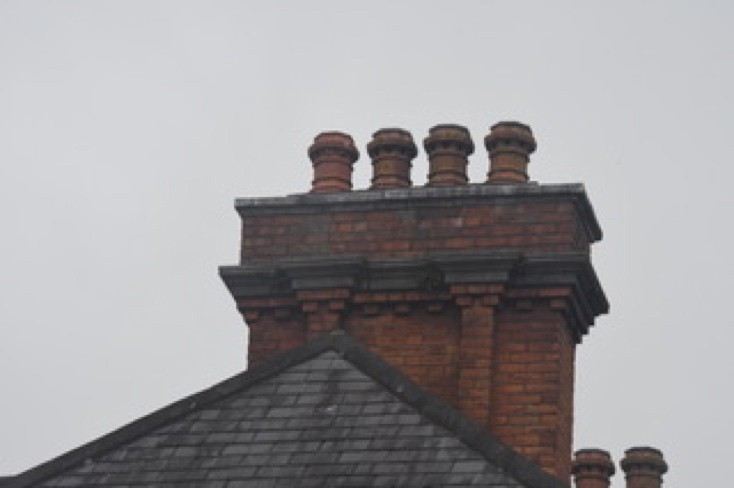
Only one pair of chimneys survives on the steeply- pitched roof of the original Custom House building. If you look closely at the depiction of the Custom House in John Butt’s fascinating View Of Cork, painted in about 1750 and housed just below these chimneys on the first floor of the gallery, you might be able to make out a further chimney, or perhaps pair of chimneys, on the southern end of the roof. On a classical building of this nature, it is more likely that there would originally have been chimneys at either end of the roof, to balance each other out visually. The rather elegant pilasters or attached square columns which adorn the side of the chimneys may be a later detail, as the brick on the chimneys would have been replaced, along the brick elsewhere on the building, in 1884.

This triangular limestone pediment is one of four above the first floor windows in the central, recessed part of the eastern façade of the original Custom House. Pediments are a typical classical detail, often used above a portico or screen of columns on the façade of a building, but here as a decorative detail to enliven the façade of the brick building.

The copper roof to the distinctive, tall polygonal turret serves to mark from a distance the entrance to the 1884 extension to the original Custom House building, built when it became the Crawford School of Art. The architects Henry and Arthur Hill, while maintaining the same palette of materials of brick and local white limestone, distinguished the new extension from the original classical building by their use of Gothic Revival details such as this picturesque turret.
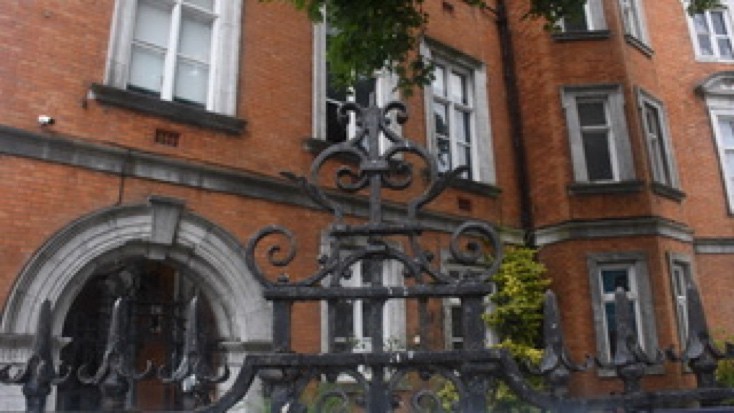
The beautiful painted wrought-iron railings and gates around the Crawford Art Gallery date to the 1884 extension of the building. They are the work of the important art metal worker B. Watson, who was based on nearby Robert Street. According to design historian Tom Spalding, Watson was one of a wave of English craftsmen (like the fathers of Patrick Pearse and Harry Clarke) who came to Ireland in the 1860s-80s to work on the Irish church building boom, and remained here, bringing their talents to really fine craftwork such as these exceptional railings. The survival of the railings in such good condition is a testament to the quality of their design and manufacture.
Up the Crawford Walls was created by Brian O’Sullivan, info texts by Katherine McClatchie, Conservation Historian
1. Grab a piece of the puzzle on the left of the screen.
2. Drag the piece to its place on the photo of the gallery
3. To learn more about the building and its history, click on the photos on the right of the screen
We hope you enjoyed Up the Crawford Walls!

A segmental-headed limestone pediment above the tall first floor window on the northern projecting bay of the original Custom House. This feature is a common decorative device used to add interest to a classical façade. The combination of segmental headed pediments and triangular pediments found at first floor level on the Custom House is most closely associated with the work of Michelangelo, as talented and important an architect as he was a sculptor. Michelangelo interpreted the rules of Roman classical architecture and used them in an innovative, while still classically rigorous way.

A pineapple-shaped carved limestone finial. There are two pineapple-shaped finials above the central doorway of the original Custom House building, which was built in 1724 and originally faced the King’s Dock (now Emmet Place). The pineapple was a popular architectural motif in the 18th and 19th centuries, and in many cases it is used as a symbol of hospitality. A thriving trade in pineapples between Europe and the Caribbean emerged in the late 17th century, and they became a prestigious symbol of international trade. There are tales of American sea captains who, upon returning from a voyage, would place a pineapple outside their home as a symbol of their safe return.

Shallow white limestone blocks are used to articulate the corners of the projecting bays on the eastern faced of the original 1724 Custom House building. The beautiful silvery-white local Cork limestone used to form the decorative details of this building were intended to provide a visual contrast to the original red brick, which is likely to have been imported, possibly from the Netherlands. The brick we can now see on the building dates from 1884, when the original red brick was replaced with new brick to match the extension of that date.

The central bay of the eastern façade of the original 1724 Custom House is flanked by two storeys of engaged limestone columns. At ground floor level, to either side of what would originally have been the main entrance to the building, is a pair of Tuscan columns. The term ‘Tuscan’ here refers to one of the five classical orders: Tuscan, Doric, Ionic Corinthian and Composite. The orders are most easily recognisable by the differences in the carved details of the capitals at the top of their columns. Here, the capital of this column indicates the simplest of the five orders: the Tuscan order, with a plain, square capital above a bulbous astragal.

The central bay of the eastern façade of the original 1724 Custom House is flanked by two storeys of engaged columns. Here, at first floor level, on either side of the tall central window, there is a pair of Ionic columns. The Ionic order is recognisable by the curved volutes at the four corners of the capital, at the top of the column. The first floor of the Custom House was the most important of the building’s three original floors: behind these central bays lies the Long Room, where revenue payments due on goods arriving into the port of Cork were formally paid to clerks working at long tables to prepare bills of lading for ships sailing to and from Cork. The Crawford Gallery retains the original internal plan form of the Long Room.

This terracotta ventilation grille is set into the façade of the original Custom House, but it dates to the 1884 extension and alterations to the building. It is a decorative expression of the utilitarian function of providing air to the interior of the building. Victorian architects are renowned for the care they often took in the detailing of functional building elements.

After a new Custom House was built at the entrance to the Port of Cork in 1811, the earlier Custom House was given to the Royal Cork Institution, later becoming a Government School of Design and then the Crawford School of Art. A magnificent extension was added, funded by and named after William Horatio Crawford (of Beamish & Crawford brewers) to house the Crawford School of Art in 1884. The extension was designed by Cork architects Henry & Arthur Hill, and it uses the same palette of materials as the Custom House: red brick and local white limestone. The architectural expression of the 1884 extension is, however, more decorative and typical of Gothic- influenced Victorian architecture, with details like these oculus windows set into the copper-roofed octagonal turret.

Only one pair of chimneys survives on the steeply- pitched roof of the original Custom House building. If you look closely at the depiction of the Custom House in John Butt’s fascinating View Of Cork, painted in about 1750 and housed just below these chimneys on the first floor of the gallery, you might be able to make out a further chimney, or perhaps pair of chimneys, on the southern end of the roof. On a classical building of this nature, it is more likely that there would originally have been chimneys at either end of the roof, to balance each other out visually. The rather elegant pilasters or attached square columns which adorn the side of the chimneys may be a later detail, as the brick on the chimneys would have been replaced, along the brick elsewhere on the building, in 1884.

This triangular limestone pediment is one of four above the first floor windows in the central, recessed part of the eastern façade of the original Custom House. Pediments are a typical classical detail, often used above a portico or screen of columns on the façade of a building, but here as a decorative detail to enliven the façade of the brick building.

The copper roof to the distinctive, tall polygonal turret serves to mark from a distance the entrance to the 1884 extension to the original Custom House building, built when it became the Crawford School of Art. The architects Henry and Arthur Hill, while maintaining the same palette of materials of brick and local white limestone, distinguished the new extension from the original classical building by their use of Gothic Revival details such as this picturesque turret.

The beautiful painted wrought-iron railings and gates around the Crawford Art Gallery date to the 1884 extension of the building. They are the work of the important art metal worker B. Watson, who was based on nearby Robert Street. According to design historian Tom Spalding, Watson was one of a wave of English craftsmen (like the fathers of Patrick Pearse and Harry Clarke) who came to Ireland in the 1860s-80s to work on the Irish church building boom, and remained here, bringing their talents to really fine craftwork such as these exceptional railings. The survival of the railings in such good condition is a testament to the quality of their design and manufacture.
Up the Crawford Walls was created by Brian O’Sullivan, info texts by Katherine McClatchie, Conservation Historian